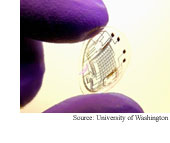|
NEWS
|
Contact lens displays
 Laboratory rabbits are wearing contact lenses
containing electronic circuits and light-emitting diodes
for 20 minutes without adverse effects. The contact lenses
are the first step toward contact-lens heads-up displays
that would project computer-generated images onto the
wearer's field of vision. (Contact Lens with Integrated
Inorganic Semiconductor Devices, 21st IEEE International
Conference on Micro Electro Mechanical Systems [MEMS 2008],
January 13-17, 2008, Tucson, Arizona)
Laboratory rabbits are wearing contact lenses
containing electronic circuits and light-emitting diodes
for 20 minutes without adverse effects. The contact lenses
are the first step toward contact-lens heads-up displays
that would project computer-generated images onto the
wearer's field of vision. (Contact Lens with Integrated
Inorganic Semiconductor Devices, 21st IEEE International
Conference on Micro Electro Mechanical Systems [MEMS 2008],
January 13-17, 2008, Tucson, Arizona)
Silicon nanowires get a charge from heat
Two ways to make silicon nanowires yield potentially
cost-effective methods of generating electricity from
heat. One technique produces silicon nanowires with rough
surfaces and the other silicon nanowires containing impurities
similar to those used in computer chips. Thermoelectric
materials hold the promise of generating electricity from
the massive amount of heat wasted by factories, power
plants, furnaces and vehicle engines. (Enhanced
Thermoelectric Performance of Rough Silicon Nanowires,
Silicon
Nanowires As Efficient Thermoelectric Materials, Nature,
January 10, 2008)
Switchgrass rules ethanol efficiency
A study of switchgrass grown for ethanol production
on 10 farms in the central United States finds that the
plant yields about five times more energy than is required
to grow it and convert it to ethanol fuel. In contrast,
ethanol derived from corn yields only about 10% more energy
than the process consumes. Ethanol produces relatively
low amounts of greenhouse gases on balance because the
plants absorb carbon dioxide from the atmosphere. (Net
Energy of Cellulosic Ethanol from Switchgrass, Proceedings
of the National Academy of Sciences, January 15, 2008)
Sound invisibility
A theoretical study shows that it's possible to
build an acoustic cloaking device similar to recently
outlined invisibility cloaks. The technique could be used
to hide submarines from sonar and to reduce reflected
noise from buildings and other objects. (Suggested
Scattering Theory Derivation of a 3D Acoustic Cloaking
Shell, Physical Review Letters, 18 January
2008)
Magnets steer cells
Researchers are using magnetic fields to steer
cells loaded with biodegradable magnetic metal particles
to the surfaces of metal implants. The technique could
be used to coat arterial stents with endothelial cells,
coat implanted metal pins and screws with bone stem cells
and to deliver drugs to specific areas of the body. (High
Field Gradient Targeting of Magnetic Nanoparticle-Loaded
Endothelial Cells to the Surfaces of Steel Stents,
Proceedings of the National Academy of Sciences,
January 15, 2008)
Programmed DNA self-assembly
It's possible to trigger DNA to self-assemble
into specific dynamic structures, including a molecular-scale
bipedal walking machine. The key is choosing the right
sequences in DNA hairpin loops. The technique could be
used to build nanomachines and molecular computers that
perform a wide range of functions including producing
drugs and targeting them to tumors and diseased tissue.
(Programming
Biomolecular Self-assembly Pathways, Nature,
17 January 2008) |
FEATURES
|
View
from the High Ground: ICL's John Pendry
Physics as machine tool, negative refractive
index, metamaterials, shattered wine glasses, higher capacity
DVDs, scientific backwaters, risk perception and practice,
practice, practice.
|
How
It Works: Quantum computing: qubits
Photons, electrons and atoms, oh my! These particles are
the raw materials for qubits, the basic building blocks
of quantum computers. |
|
 |
News RSS feed 
Blog RSS feed 
Bookshelf RSS feed

New: TRN's
Internet Services
TRN's Jobs Center
|
| |
|
| |
|
| |
"Physics
is to the rest of science what machine tools are
to engineering. A corollary is that science places
power in our hands which can be used for good or
ill. Technology has been abused in this way throughout
the ages from gunpowder to atomic bombs."
- John Pendry, Imperial College London |
|
| |
|
| |
Thanks
to Kevin from
GoldBamboo.com
for technical support |
|

